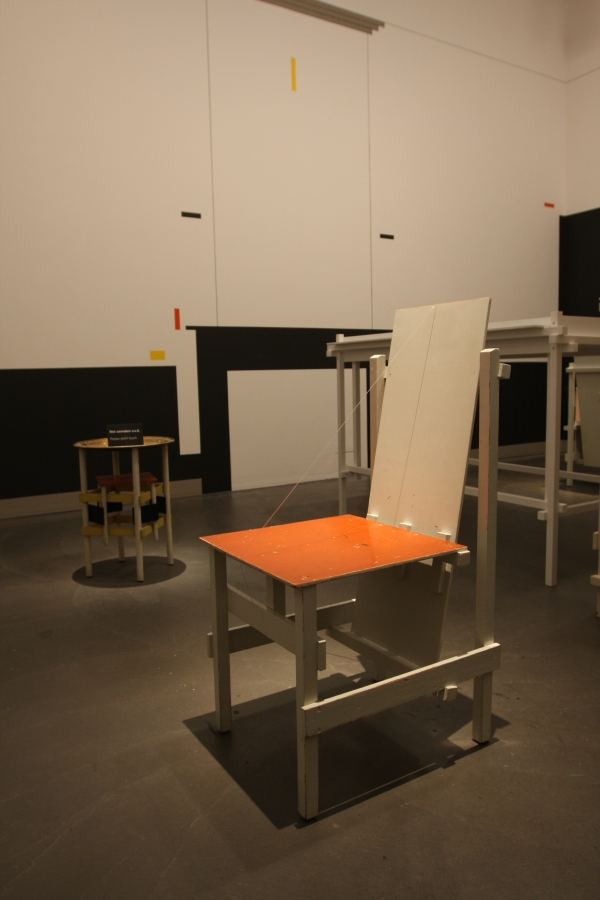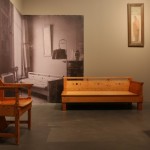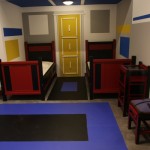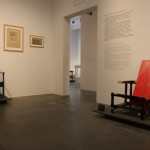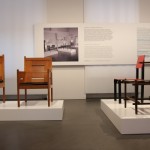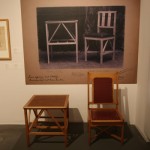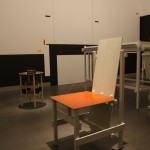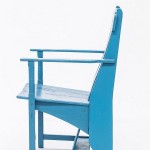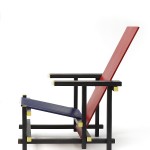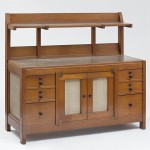Klaarhamer according to Rietveld. Craftsman, frontrunner and innovator at the Centraal Museum Utrecht
As we noted in our post from the exhibition Der entfesselte Blick – Die Brüder Rasch und ihre Impulse für die moderne Architektur at the Marta Herford, the (hi)story of architecture and design is often more about the protagonists you don’t know than the ones you do.
Such as the pioneering Dutch architect and designer Piet Klaarhamer: an early teacher of and influence on Gerrit T. Rietveld, one of the intellectual forefather’s of Dutch modernism, and a man largely forgotten by history.
In an attempt to right this wrong the Centraal Museum Utrecht are currently presenting the exhibition Klaarhamer according to Rietveld. Craftsman, frontrunner and innovator.
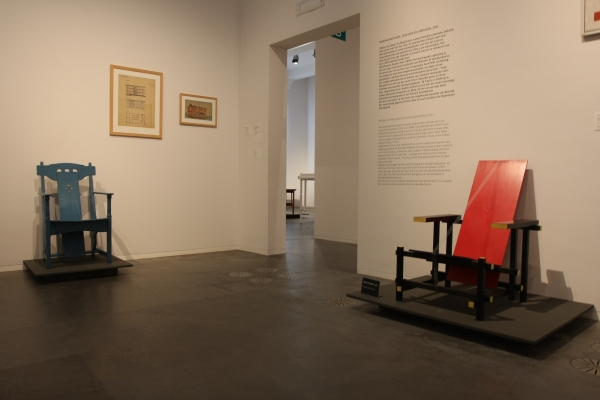
Blue Klaarhamer meets Red Blue Rietveld, as seen at Klaarhamer according to Rietveld. Craftsman, frontrunner and innovator, Centraal Museum Utrecht
Born in Zwiep, Holland on December 27th 1874 Piet Klaarhamer initially trained as a draughtsman and cabinet maker before establishing his own architecture and interior design studio in Utrecht. Greatly influenced by Hendrik Petrus Berlage Piet Klaarhamer was an early advocate of reduced, functional architecture; of buildings designed according to the practical requirements of the user and created using the latest technology and from the newest materials. As early as 1912, for example, Klaarhamer developed the concept of houses constructed from reinforced concrete and many of his architectural designs demonstrate a passionate commitment to ensuring the interiors received a maximum of natural light. In its day revolutionary thinking.
In terms of his furniture design Klaarhamer advanced a formally reserved take on Art Nouveau, creating furniture from simple woods and using simple construction methods to produce objects with an elegant rustic charm and which despite their solid nature present a very light, untroubled, character. In addition to producing furniture for his numerous interior design, shop fitting and architecture projects, Piet Klaarhamer’s furniture was also sold directly through the Utrecht department store Vroom & Dreesman, thus making him one of the best known Dutch furniture designers in the early 1900s.
Supplementary to his architecture and design work Piet Klaarhamer also taught drawing, to amongst others a young Gerrit T. Rietveld, a student who quickly became enamoured in and with Klaarhamer and his new ways of thinking about space, materials, furniture, architecture and design. The two worked closely together over many years and in 1915 Rietveld constructed numerous pieces of furniture for Klaarhamer in his father’s workshop: and so just as the Dutch Masters of yore learned to paint by copying the works of older Masters, so to did Gerrit T. Rietveld learn to understand the nature of modern furniture through constructing Piet Klaarhamer’s designs. Or as Rietveld himself phrased it following Klaarhamer’s death, “Personally I owe the foundations of my professional expertise to architect Klaarhamer, because I was one of the few who had the privilege of being his student for many years”1
What could, and indeed should, have been a close life-long friendship was irrevocably damaged in 1919 when, with Klaarhamer believing himself to be at the zenith of his creativity and influence, the magazine De Stijl – eponym of the influential 20th century Dutch modernist movement – published pictures of furniture by Gerrit T. Rietveld. And no pictures of furniture by Piet Klaarhamer.
A turn of events which, understandably or not, Klaarhamer had trouble accepting and which he allowed to sour his once close friendship with Rietveld.
While the publicity from De Stijl helped launch Rietveld on his rapid rise to international fame, the lack of acknowledgement from his peers saw Klaarhamer fall ever more into the shadows. And although Piet Klaarhamer did realise some interesting and valuable architecture projects in the 1920s, in 1933 he withdrew himself to rural Holland where he lived in near anonymity until his death in 1954.
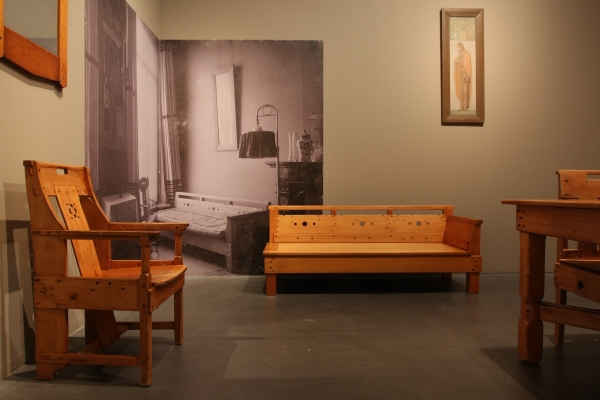
Piet Klaarhamer’s living room featuring his own furniture, ca 1908, as seen at Klaarhamer according to Rietveld. Craftsman, frontrunner and innovator, Centraal Museum Utrecht
Presenting a nice mix of furniture, sketches, photographs and other documentation Klaarhamer according to Rietveld both introduces the work of Piet Klaarhamer and also helps explain his influence on and importance for the development of architecture and design in the first quarter of the 20th century, including, for example, elucidations of his understanding of space and room design, his experimental use of concrete for house construction and some of his more important architectural contributions in and around Utrecht. In addition to providing an excellent introduction to Piet Klaarhamer the exhibition is also a nice stroll through Gerrit T. Rietveld’s canon, featuring as it does many of his works, works which are neatly juxtapositioned with Klaarhamer’s and thus ably demonstrating how and where Klaarhamer’s influence can be found in Rietveld’s furniture design work.
Beyond Klaarhamer and Rietveld the exhibition also looks at the nature of Klaarhamer’s relationships with the Dutch abstract painter Bart van der Leck and the architect Robert van ‘t Hoff, and so by extrapolation explains the influence these two men had on the development of Rietveld’s understanding of art, architecture and design.
What the exhibition, regrettably, doesn’t do is explain why De Stijl choose to ignore Piet Klaarhamer. Does however present some very strong clues; most notably from that fateful year of 1919.
For Piet Klaarhamer one of his most important and prestigious projects from 1919 was furniture for the bedroom of the sons of Utrecht industrialist Cees Bruynzeel. Yet while the so-called Bruynzeel boys’ room furniture is without question ahead of its time, challenging of its day and formally very interesting….. it just isn’t as ground-breaking, forward thinking or provocative as the works Rietveld was producing at that time.
Rietveld’s furniture designs of that period fitted the brave new world that De Stijl was preparing the Netherlands for. Klaarhamer’s in contrast still had one foot in the past. And didn’t look like it would have the bravery to move on.
And so one has to say that the De Stijl editors got it right.
Hard as that may have been for Klaarhamer to accept and disastrous as the consequences may have been for his personal life and future career.
On a related note, another aspect which the exhibition fails to explain is what role personal relationships played in decisions as to who appeared in De Stijl and who didn’t. We know that would mean going a bit off subject and looking in more detail at the internal politics of De Stijl, would however be a valuable, and we feel highly relevant, insight. Not least because it would help clear up the obvious question as to in how far Klaarhamer’s reaction to the publication of Rietveld’s work and lack of acknowledgement for his own was a childish tantrum, or if it was an understandable acceptance of a community against him, to a deliberate snub from a world which didn’t want him. And only when you know the answer to that question can you decide in how far Klaarhamer alone was to blame for his ultimate fate.
In which context one must also add that following events of 1919 Piet Klaarhamer didn’t do himself any favours when he made a near unforgivable error and began “copying” his former pupil. Whereas Klaarhamer’s furniture designs from before 1919 are self-confident pieces created to his understanding of design, many of those from after 1919 look like apologetic Rietveld imitations. There are admittedly some very, very nice pieces to be found; but, you don’t make your impact on a movement by creating homages to one of its leading figures.
A well conceived, nicely paced, accessible and intelligently presented exhibition Klaarhamer according to Rietveld attempts to present Piet Klaarhamer as a victim of circumstances. As a man robbed of his plinth alongside architecture’s greats. For us that is too simple. Much like Henry van de Velde Piet Klaarhamer recognised the spirit of the age, the need for change and the necessity of embracing technological advances for the benefit of society. And just like Henry van de Velde Piet Klaarhamer reached his own creative peak before the ideals he followed had reached, or indeed could have reached, their full maturity. Evolution however needs intermediary stages, moments when transformations aren’t complete but where the break with the former has been made and the foundations of the new laid. Piet Klaarhamer was such a intermediary, and should be celebrated as such and remembered for the invaluable contribution he made to helping others complete the process.
Despite the unfortunateness from 1919 Rietveld remained both grateful for what Klaarhamer had taught him and a keen admirer of the man and his work, and indeed following Klaarhamer’s death Rietveld wrote the only obituary for his for former mentor to be published. Rietveld ends his text with the words, “Some years ago I paid him a visit to ask his permission to write about his work. I cannot stop you, he told me, but be aware that you will do so against my will. I then respected his wishes, although it was not what I wanted.”2
Klaarhamer according to Rietveld. Craftsman, frontrunner and innovator is a more than fitting replacement for that unwritten text.
We’re sure Rietveld would agree.
And are equally sure Piet Klaarhamer would appreciate the fulsome, if somewhat overdue, celebration of his oeuvre.
Klaarhamer according to Rietveld. Craftsman, frontrunner and innovator runs at the Centraal Museum, Nicolaaskerkhof 10, 3512 XC Utrecht until Sunday March 22nd
Full details can be found at http://centraalmuseum.nl
1. “In Memoriam Architect P.J. Klaarhamer” by Gerrit T.Rietveld. Originally published in Bouwkundig Weekblad, 1954. Translated and reproduced in Klaarhamer according to Rietveld. Craftsman, frontrunner and innovator
2. ibid
- Piet Klaarhamer’s living room featuring his own furniture, ca 1908, as seen at Klaarhamer according to Rietveld. Craftsman, frontrunner and innovator, Centraal Museum Utrecht
- Bruynzeel Boys’ Bedroom, 1919, by Piet Klaarhamer (furniture) and Vilmos Huszár (colour scheme), as seen at Klaarhamer according to Rietveld. Craftsman, frontrunner and innovator, Centraal Museum Utrecht
- Blue Klaarhamer meets Red Blue Rietveld, as seen at Klaarhamer according to Rietveld. Craftsman, frontrunner and innovator, Centraal Museum Utrecht
- Two chairs from Piet Klaarhamer (left) and two from Gerrit T. Rietveld (right), as seen at Klaarhamer according to Rietveld. Craftsman, frontrunner and innovator, Centraal Museum Utrecht
- Side table and chair Piet Klaarhamer, both ca 1904, as seen at Klaarhamer according to Rietveld. Craftsman, frontrunner and innovator, Centraal Museum Utrecht
- A Piet Klaarhamer chair from 1928. No honest, it is Klaarhamer…… Honest!
- Blue Chair by Piet Klaarhamer, 1906, (Photo: Ivar Pel, Courtesy Centraal Museum Utrecht)
- Red and blue chair by Gerrit T. Rietveld, 1918 (Photo & copyright CMU/ photo Ernst Moritz, Courtesy Centraal Museum Utrecht)
- A Cabinet by Piet Klaarhamer ca.1920 (Photo & copyrights CMU / Ernst Moritz 2014 – 05 – 27, Courtesy of Centraal Museum Utrecht)
Tagged with: Gerrit T.Rietveld, Klaarhamer according to Rietveld, Piet Klaarhamer, Utrecht
